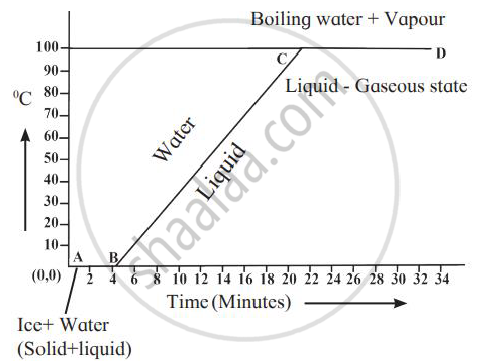Advertisements
Advertisements
प्रश्न
Define the term ‘specific latent heat of fusion’ of a substance.
उत्तर
Specific latent heat of fusion: The specific latent heat of fusion of a substance is the heat energy released when a unit mass of substance converts from liquid to solid state without the change in temperature.
APPEARS IN
संबंधित प्रश्न
The specific latent heat of fusion of water is ______.
A molten metal of mass 150 g is kept at its melting point 800℃. When it is allowed to freeze at the same temperature, it gives out 75,000 J of heat energy.
- What is the specific latent heat of the metal?
- If the specific heat capacity of metal is 200 J kg-1 K-1, how much additional heat energy will the metal give out in cooling to -50℃?
Calculate the total amount of heat energy required to convert 100 g of ice at −10℃ completely into water at 100℃. Specific heat capacity of ice = 2.1 J g-1 K-1, specific heat capacity of water = 4.2 J g-1K-1, specific latent heat of ice = 336 J g-1.
Answer the following:
Explain the role of latent heat in the change of state of a substance.
Liquid ammonia is used in ice factory for making ice from water. If water at 20°C is to be converted into 2 kg ice at 0°C, how many grams of ammonia are to be evaporated? (Given: The latent heat of vaporization of ammonia = 341 cal/g)
A thermally insulated pot has 150 g ice at temperature 0°C. How much steam of 100°C has to be mixed to it, so that water of temperature 50°C will be obtained? (Given : latent heat of melting of ice = 80 cal/g, latent heat of vaporization of water = 540 cal/g, specific heat of water = 1 cal/g °C)
Explain the following temperature vs time graph.

Define the following terms:
(i) Latent heat,
(ii) Latent heat of fusion of ice.
Give one consequence of the high specific latent heat of fusion of ice.
The specific latent heat of vaporisation of steam is 2260 J/g. Comment on this.
Why do we feel much comfortable when we sit under a moving fan especially when our body is sweating?
Why does evaporation causes cooling and why is water used in hot water bottles?
Derive an expression for the amount of heat given out or taken up, when its temperature falls or rises by t°C.
Steam at 100°C is passed over 1000 g of ice at 0°C. After some time, 600 g of ice at 0°C is left and 450 g of water at 0°C is formed. Calculate the specific latent heat of vaporization of steam (Given: specific heat capacity of water = 4200 J/kg°C, specific latent heat of fusion of ice = 336,000 J/kg.)
If there is no Heat loss to the surroundings, the heat released by the condensation of m1 g of steam at 100°C into water at 100°C can be used to convert m2 g of ice at 0°C into water at 0°C.
(i) Find:
(a) The heat lost by steam in terms of m1
(b) The heat gained by ice in terms of m2
(ii) Form a heat equation find the ratio of m2 : m1
Specific latent heat of vaporization of steam = 2268 kJ/kg
Specific latent heat of fusion of ice = 336 kJ/kg
Specific heat capacity of water = 4200 J/kg°C
Find the odd one out and give its explanation.
1 kg of dry air at a temperature of 40 °C can hold a maximum of 49 g of water vapour.
Define specific latent heat capacity
